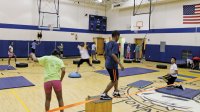Tough Mudder Goes to the Gym
Engage all students in gym by updating the old familiar obstacle course. Plus, you can include discussions on growth mindset.
It’s a familiar scene: The first students enter the gym and run to the locker room as fast as they can. Like Superman emerging from the phone booth, they are changed and ready to participate in a flash, racing to their physical education teacher. “What are we doing today?” they ask with excitement.
Minutes pass by as they wait for their classmates to get ready. Students straggle out of the locker room, ready but not eager to get started. “So... what are we doing today?” they nervously ask.
The goal of any PE class is to find engaging activities that promote physical, mental, and social well-being in all students. While the number of sports and games out there is endless, not all motivate students to achieve their personal best. With the range of athletic abilities in a class, confident movers shine during team sports while passive students fade into the role of observers. During fitness activities, students strive for their personal best, but most agree that they’d rather be participating in something more fun. It’s rare to find an activity that captivates all students while achieving PE standards. However, a new twist on the old-fashioned obstacle course comes close to accomplishing this goal.
The popularity of obstacle course races such as the Tough Mudder and Spartan Races and the TV show American Ninja Warrior has produced an interest in kids to move in new ways. Using these examples as inspiration, and shifting the focus to athlete vs. course, can have a major impact on participation. Students of all levels of athletic ability can have challenges that push them appropriately, and the less competitive can participate without worrying about a score being kept or having to perform against a peer.
A Sense of Excitement
Back in the gym, the excitement level rises as students realize what they are about to do. The visual impact of all the equipment laid out over the gym floor has students talking: “I can’t wait to try this!”
As the PE teacher demonstrates the course, he explains that students are trying to reach the finish without touching the gym court—if they do that, it’s back to the starting line.
The physical health benefits of the activity are obvious. Balance, power, and agility are on full display as students walk across beams, jump from mat to mat, and spring off a mini trampoline. One student clings desperately to the rope swing, trying to make it to a safe spot. Another runs across the tires and then rests for a moment atop a small mat, thinking out her next move. The mix of running, jumping, and climbing test students’ muscular strength, and as they either complete or fail the course, running to the start to have another try keeps the energy level high. A whole class period of effort and that ever-desired moderate to vigorous physical activity level is achieved.
Even with the individual aspect of the course, the activity is plenty social. Watch any mud run event and you’ll see solidarity among competitors and helping hands supporting each other through the challenges. Embracing this culture in the gym has students lining up with their friends, competing against the course together. They support each other along the way, passing along tips and hoping they will all make it to the end together.
Today the final obstacle is a pile of mats stacked up about 5 feet tall. Jumping and climbing to the top and ringing the bell allows students to sign their name on the Wall of Fame and claim their title as ninja warrior. The feeling of pride in students’ faces when they make it is obvious. For others, that moment occurs in the middle of the course. Seeing students persevere past a difficult spot is just as memorable, and a teachable moment worth noting.
There is no perfect activity in PE, but a dynamic obstacle course comes close. All students are given the chance to move in a fun way while overcoming physical and mental obstacles. Teaming the activity with conversations about perseverance, confidence, and growth mindset makes the lessons that much more impactful. It is clear the objectives for the day have been met when kids are saying things like, “This is like a workout,” “I’m not stopping until I get this,” or “I like it because even though I’m short, I can still do it.”
Doing It Yourself
Many obstacles can be created with equipment most schools already have or with a minimal investment. Here are some ideas to get you started:
- Use 2x4s and 4x4s to make balance beams.
- Pick up rope at a hardware store for rope swings hung from backboards.
- Look for mini trampolines at yard sales or thrift shops.
- Ask a local tire shop to donate some tires.
- Use bleachers, pull-up bars, and other built-ins around the gym.
- Incorporate hurdles, scooters, and other equipment.
There is a warrior inside each student—give them all a reason to celebrate coming to class and help bring out the best in them.
